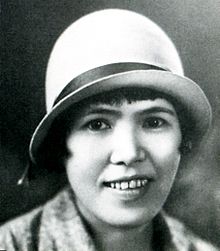Nobuko Yoshiya
| Nobuko Yoshiya | |
|---|---|

Nobuko Yoshiya
|
|
| Born |
12 January 1896 Niigata, Japan |
| Died | 11 July 1973 (aged 77) Kamakura, Kanagawa, Japan |
| Occupation | Novelist |
Nobuko Yoshiya (吉屋信子 Yoshiya Nobuko?, 12 January 1896 – 11 July 1973) was a Japanese novelist active in Taishō and Showa period Japan. She was one of modern Japan's most commercially successful and prolific writers, specializing in serialized romance novels and adolescent girls' fiction, as well as a pioneer in Japanese lesbian literature, including the Class S genre. Several of her stories have been made into films.
Yoshiya was born in Niigata prefecture, but grew up in and cities in . Her father was first a police officer and then became a local county government official, so her family relocated often to accommodate his transfers. She was the only daughter and youngest of five children in her family. Both her mother and her father came from samurai families. Her middle-class, culturally conservative parents trained her for the "good wife, wise mother" role expected of women in Meiji Japan. Her literary career began when she was in her teens, although prior to this she had developed a love for writing which sapped her time for learning domestic skills from her mother.
In 1915 she moved to Tokyo, where she began to diverge from Japan's career and gender expectations. Yoshiya often dressed in an androgynous style, including in magazine photo sessions. She was one of the first Japanese women to emulate Western fashion in the 1920s by cutting her hair short. Yoshiya defied expectations in other ways. She was one of the first Japanese women to own a car, she designed her own house, and was the first Japanese women to own a racehorse, which (along with golf) would become a passion of hers.
Yoshiya lived in Kamakura, Kanagawa prefecture during and after World War II. In 1962 she built a traditional wooden house with Japanese-style garden in a quiet setting, which she willed to the city of Kamakura on her death, to be used to promote women's cultural and educational activities. She died at age 77 of colon cancer. Her house is now the Yoshiya Nobuko Memorial Museum, and preserves the study as she left it, with items such as handwritten manuscripts and favorite objects are on display. However, the museum is open only twice a year, in early May and November, for three days each time. Her grave is at the temple of Kōtoku-in in Kamakura, behind the famous Kamakura Daibutsu.
...
Wikipedia
